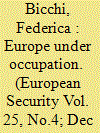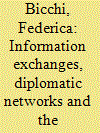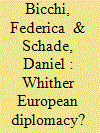|
|
|
Sort Order |
|
|
|
Items / Page
|
|
|
|
|
|
|
| Srl | Item |
| 1 |
ID:
148316


|
|
|
|
|
| Summary/Abstract |
This article shows how the existence of a community of European practitioners in the Jerusalem area gives substance to the European stance on the Israeli–Palestinian conflict. The often-stated European Union (EU) support for a two-state solution could appear meaningless in the absence of peace negotiations. However, European diplomats (i.e. diplomats of EU member states and EU officials) in the East Jerusalem–Ramallah area are committed to specific practices of political resistance to Israeli occupation and recognition of Palestinian institutions. These practices have led not only to a specific political geography of diplomacy, but also to a community of practice, composed of European diplomats and based on their daily experience of resisting occupation and bestowing recognition. It is this group of officials who represent and actively “do” Europe’s position and under occupation.
|
|
|
|
|
|
|
|
|
|
|
|
|
|
|
|
| 2 |
ID:
158364


|
|
|
|
|
| Summary/Abstract |
The article analyses how the Europeans (meaning European states and the EC/EU) have progressively turned a discourse about the Israeli-Palestinian border into a foreign policy practice. While much of the literature highlights the existence of a ‘gap between discourse and practice’ when it comes to Europeans’ foreign policy stance towards the Arab-Israeli conflict, we argue that the gap is dynamic and has changed across time. In the absence of an internationally and locally recognised border between Israel and Palestine, the Europeans have aimed at constructing one on the 1949 armistice line, the so-called Green Line. They have done so in stages, by first formulating a discursive practice about the need for a border, then establishing economic practices in the late 1980s-early 1990s, and most recently practicing a legal frame of reference for relations with Israel and the Palestinian Authority (PA) based on the Green Line. The outcome is that, for what concerns European countries and EU legislation, the Green Line has been increasingly taken as the Israeli-Palestinian border. However, gaps never fully close and more contemporary events seem in fact to point to a re-opening of the gap, as the article explores.
|
|
|
|
|
|
|
|
|
|
|
|
|
|
|
|
| 3 |
ID:
132330


|
|
|
|
|
| Publication |
2014.
|
| Summary/Abstract |
This article analyses how, within the European Union foreign policy system, information is gathered and knowledge is constructed. The analysis is based on the evidence provided by a unique dataset, comprising the Heads of Mission reports between 1998 and 2010 and the EU member states' diplomatic networks. After distinguishing between information and knowledge, the article tackles three related aspects. First, it shows that the EU is able not only to favour information exchanges, but also to gather information and construct knowledge. Second, it argues that, while member states have an interest in contributing their own information and knowledge, European knowledge is also possible. This is demonstrated by means of an in-depth analysis of the preparation of the Heads of Mission report on East Jerusalem. Third, the article suggests that, depending on the reach of their diplomatic network, some member states are interested more than others in European information, but all member states are interested in European knowledge and in each other's interpretation of current affairs
|
|
|
|
|
|
|
|
|
|
|
|
|
|
|
|
| 4 |
ID:
184038


|
|
|
|
|
| Summary/Abstract |
The article analyses the evolution of European diplomacy over two decades, to assess the impact of the European External Action Service (EEAS) creation alongside consecutive waves of enlargement. Data is drawn from two original datasets about European Union (EU) member states’ diplomatic representations within the EU and across the globe. It shows that member states have maintained and strengthened their substantial diplomatic footprint across the EU’s territory, expanding it to include new members and making Brussels a diplomatic hub also for non-member countries. In parallel, and despite the establishment of the EEAS, member states have maintained and even increased their networks of diplomatic representations across the globe, alongside more numerous and more politically active EU Delegations (EUDs). At the same time, member states have been reducing their diplomats’ numbers, as the cases of Austria, France, Germany and Italy show. This delicate balancing act has been made possible not only by contemporary technological developments, but also by European cooperation, as in the case of EUDs hosting member states’ representations in non-member countries, a development referred to as co-location. Therefore, whereas the continued presence of national embassies on the ground could be interpreted as detracting from the EEAS, the existence of EUDs contributes also to other, more indirect but certainly novel, forms of diplomatic cooperation under a single European roof.
|
|
|
|
|
|
|
|
|
|
|
|
|
|
|
|
|
|
|
|
|